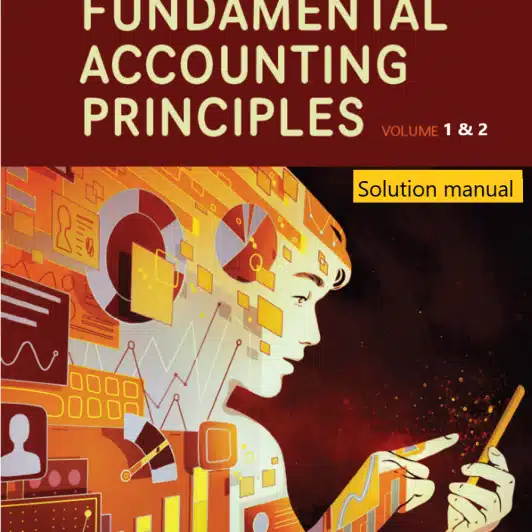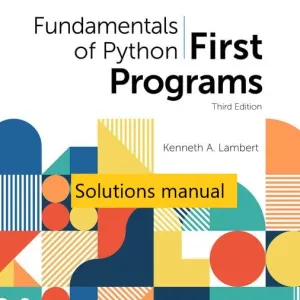Original price was: $79.990.$34.990Current price is: $34.990.
Solution manual for Fundamental Accounting Principles Volume 1 & 2 18th Edition By Kermit D. Larson © 2025
Product ID: 0914400
Downloadable link.
For Contact: [email protected]
Description
Solution Manual for Fundamental Accounting Principles, Volume 1 & 2, 18th Edition
By Kermit D. Larson © 2025
Product Overview
The *Solution Manual for Fundamental Accounting Principles, Volume 1 & 2, 18th Edition by Kermit D. Larson is an essential resource for students and instructors of accounting. This comprehensive manual follows a direct, concise, and systematic approach to accounting, designed to simplify complex concepts and help students build confidence in mastering key accounting procedures.
Each chapter begins with engaging vignettes that feature dynamic entrepreneurs, showing students the real-world relevance of accounting concepts. This approach encourages students to think like business professionals and apply what they learn in practical scenarios. In addition, a wide variety of assignments are provided, allowing instructors the flexibility to teach, assess, and challenge students at multiple levels.
The Solution Manual also integrates McGraw Hill’s Connect technology, a powerful and user-friendly homework and learning management system that enhances learning through adaptive tools and learning science. These resources enable students to better understand the concepts, while helping instructors manage their courses efficiently and effectively.
Key Features of the 18th Edition
1. Direct, Concise, and Systematic Approach
The 18th Edition of Fundamental Accounting Principles is known for its clear and concise writing style, making complex accounting processes accessible to students. It simplifies the learning experience, enabling students to understand and apply essential concepts easily.
2. Real-World Relevance
Each chapter includes dynamic vignettes that highlight real-world business examples, making accounting principles more relevant and engaging for students. These examples show how accounting directly impacts business operations, which is invaluable for those pursuing careers in business or finance.
3. Integration with Connect Technology
The textbook utilizes McGraw Hill Connect, a digital learning platform that offers powerful tools for homework, assessments, and learning management. The system includes:
-
Adaptive learning tools that adjust to the student’s level of understanding.
-
Interactive assignments that help students master fundamental concepts and apply them to real-life scenarios.
4. Comprehensive Coverage of Accounting Topics
This edition covers a wide range of essential accounting topics, from basic principles to more complex concepts such as corporate reporting, investments, and financial statement analysis. Both Volume 1 and Volume 2 ensure that students gain a deep and well-rounded understanding of accounting.
Table of Contents
VOLUME 1
-
Preface
Overview of the book and its objectives, setting the stage for the content covered in the textbook. -
Chapter 1: Accounting in Business
Introduces the concept of accounting and its role in business decision-making. -
Chapter 2: Analyzing and Recording Transactions
Covers how transactions are recorded and analyzed in the accounting system, including debits and credits. -
Chapter 3: Adjusting Accounts for Financial Statements
Explains how to make adjusting entries to prepare accurate financial statements. -
Chapter 4: Completing the Accounting Cycle and Classifying Accounts
Focuses on the steps involved in completing the accounting cycle and classifying accounts. -
Chapter 5: Accounting for Merchandising Activities
Discusses the accounting processes involved in merchandising, including the recording of sales and inventory. -
Chapter 6: Inventory Costing and Valuation
Explores different methods for inventory valuation and how to apply them in accounting. -
Chapter 7: Internal Control and Cash
Explains internal control systems and how businesses manage cash to prevent fraud and errors. -
Chapter 8: Receivables
Focuses on the accounting for accounts receivable, including the recognition of bad debts. -
Chapter 9: Property, Plant, and Equipment and Intangibles
Describes the accounting for long-term assets like property, plant, and equipment, as well as intangible assets. -
Appendix I: Payroll Liabilities
Provides insight into accounting for payroll liabilities, including wages, taxes, and benefits. -
Appendix II: Accounting Information Systems
Explains the role of information systems in accounting and how they facilitate data processing. -
Appendix III: Financial Statement Information
Offers guidance on understanding and interpreting financial statements. -
Appendix IV: Chart of Accounts
Lists the basic chart of accounts used in accounting for various business transactions.
VOLUME 2
-
Chapter 9: Property, Plant, and Equipment and Intangibles
Continues the discussion of long-term assets, focusing on depreciation, amortization, and impairment. -
Chapter 10: Current Liabilities
Covers the accounting for short-term liabilities such as accounts payable and short-term loans. -
Chapter 11: Partnerships
Explains the accounting treatment for partnerships, including profit-sharing and the distribution of earnings. -
Chapter 12: Organization and Operation of Corporations
Focuses on the structure and operations of corporations, including stock issuance and dividends. -
Chapter 13: Corporate Reporting: Profit, Earnings Per Share, and Retained Earnings
Covers corporate reporting requirements, focusing on earnings per share (EPS) and retained earnings. -
Chapter 14: Bonds and Long-Term Notes Payable
Discusses the accounting for long-term debt, including bonds and notes payable. -
Chapter 15: Accounting for Debt and Share Investments
Explains how to account for investments in debt securities and equity securities. -
Chapter 16: Reporting and Analyzing Cash Flows
Provides a guide on how to prepare and analyze the cash flow statement. -
Chapter 18: Analyzing Financial Statements
Teaches students how to use financial ratios and other tools to analyze and interpret financial statements. -
Appendix I: Payroll Liabilities
Recaps the accounting for payroll liabilities. -
Appendix II: Financial Statement Information
Provides additional insights into financial statement information. -
Appendix III: Chart of Accounts
Lists the updated chart of accounts for Volume 2.
For more test banks and manual solutions, click here.







Focused on fundamentals
Precise explanation
Helps retention